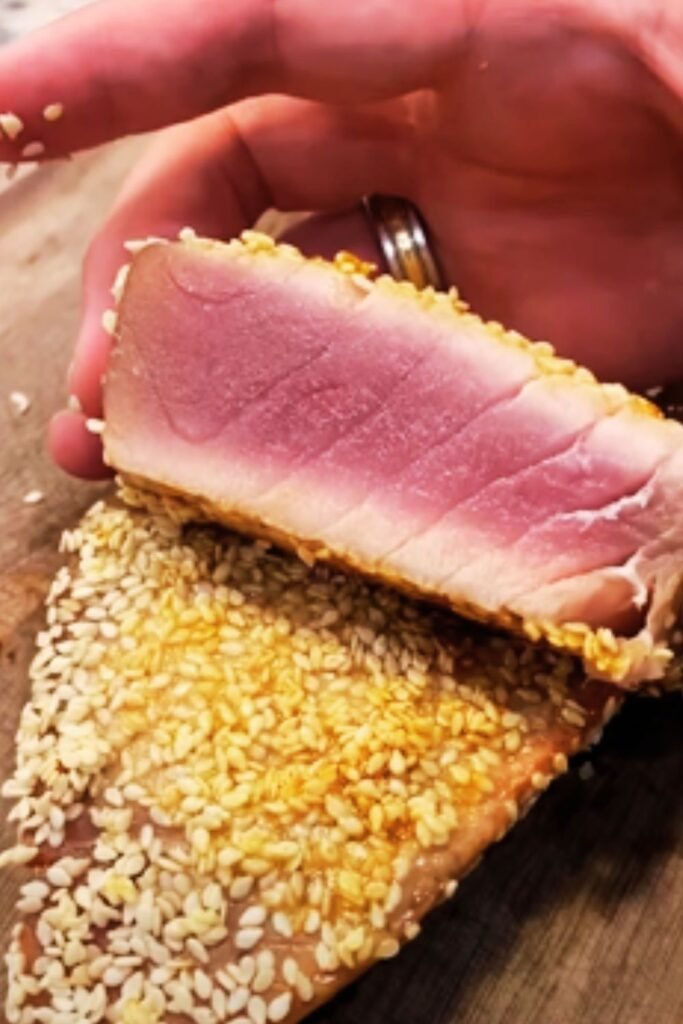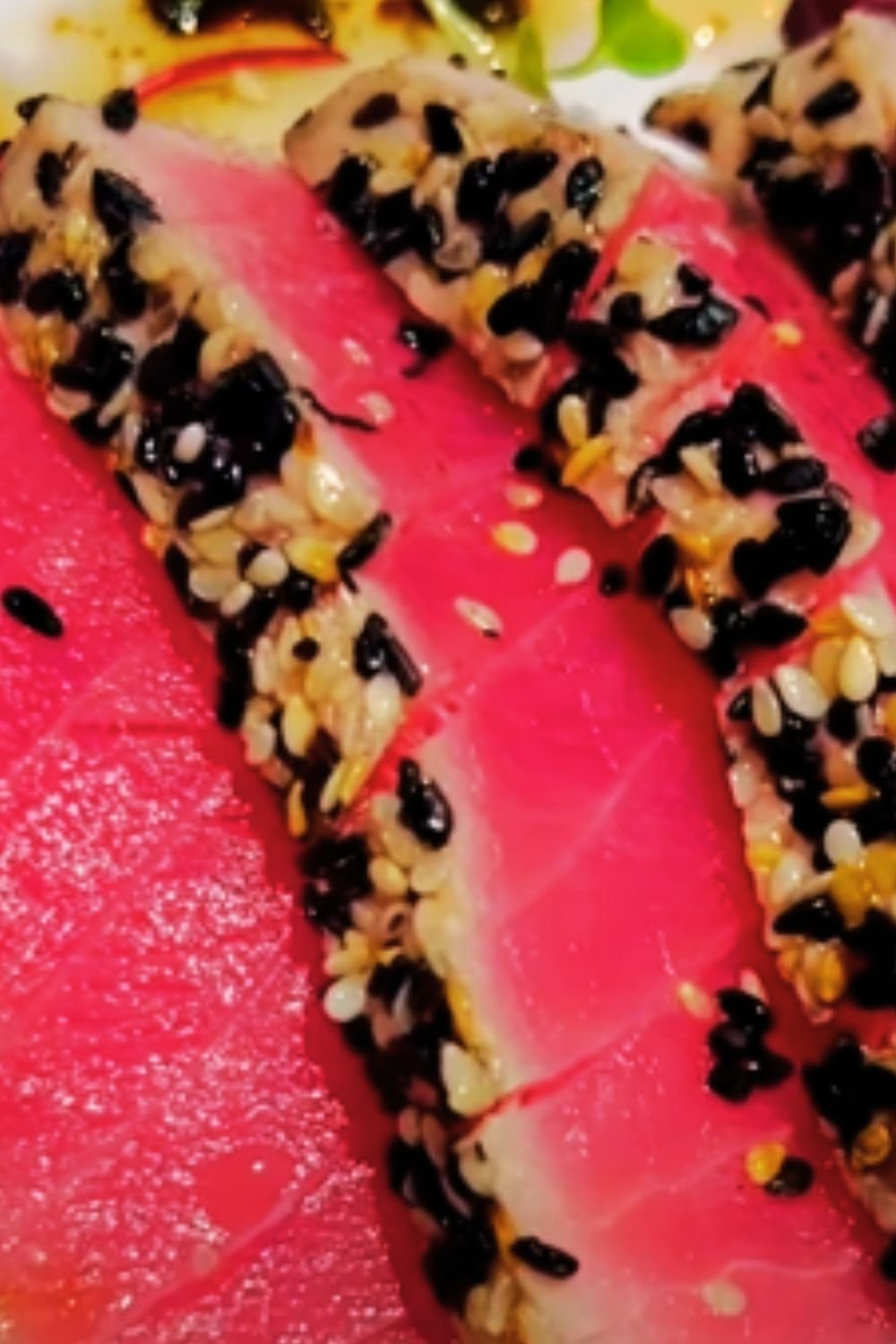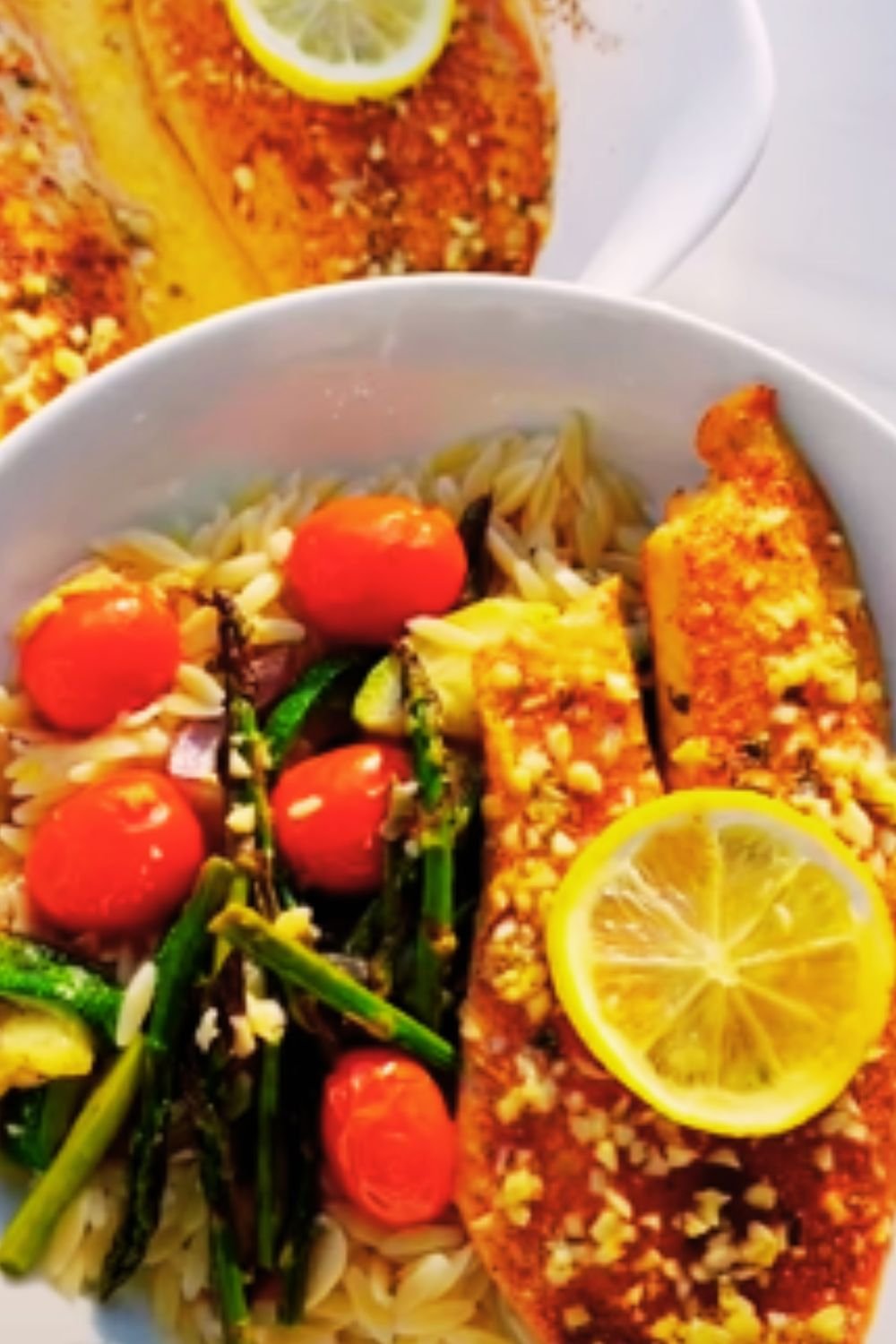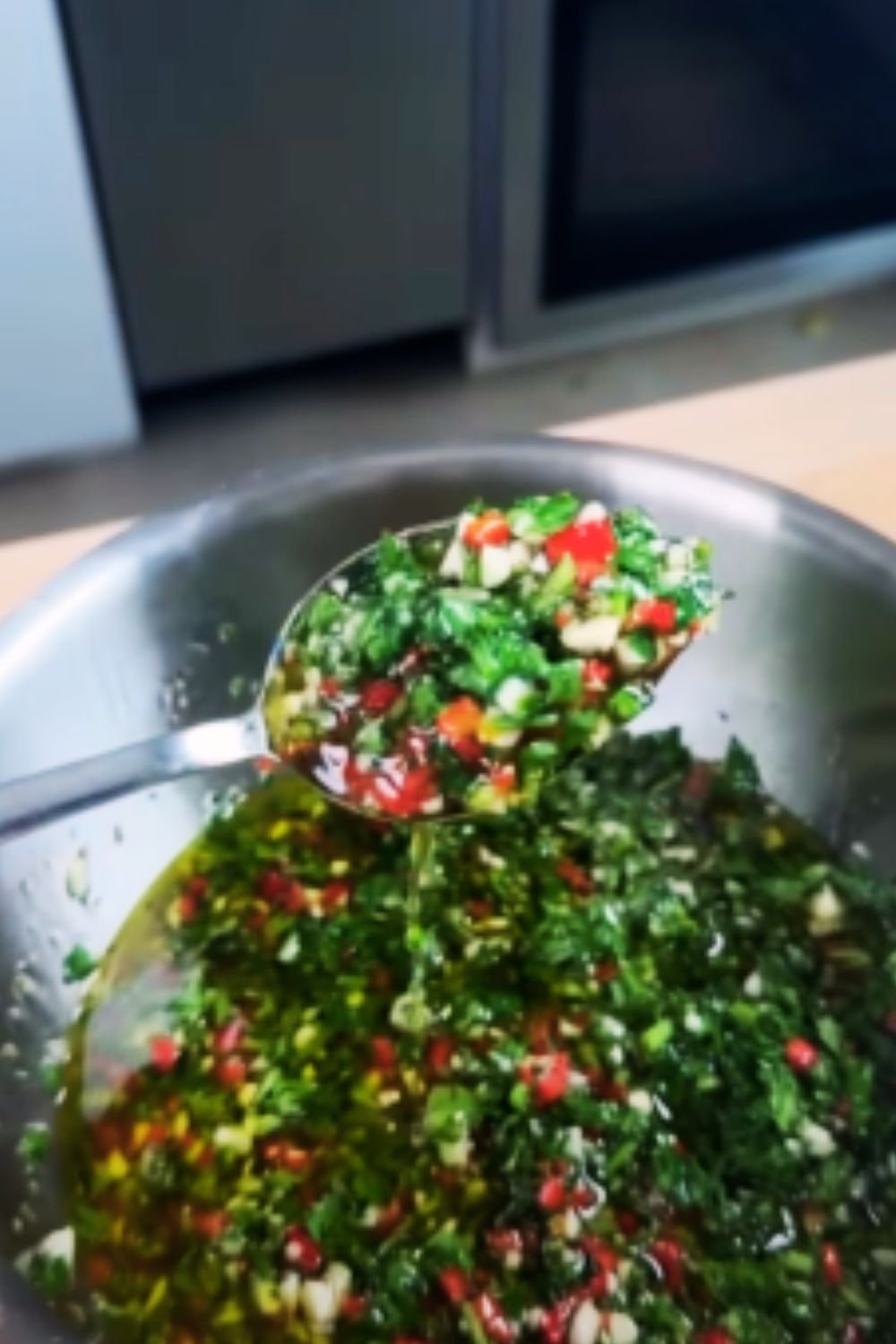There’s something magical about the moment a perfectly seared tuna steak hits your plate—that gorgeous contrast between the golden-brown sesame crust and the vibrant pink center. I’ve been perfecting this dish for years, and I’m thrilled to share my ultimate sesame-crusted tuna steak recipe with you today, complete with a zingy ginger-soy sauce that elevates this dish to restaurant-quality status right in your home kitchen.
This impressive yet surprisingly simple dish has become my go-to when I want to treat myself or wow dinner guests. The combination of nutty sesame seeds, premium tuna, and the umami-packed sauce creates a harmony of flavors that feels indulgent but takes just minutes to prepare. Whether you’re new to cooking seafood or a seasoned chef, I’ll guide you through each step to ensure stunning results.
Why You’ll Love This Recipe
Before we dive into the details, let me tell you why this dish deserves a spot in your cooking repertoire:
- Quick luxury: The entire dish comes together in less than 20 minutes
- Nutritional powerhouse: Tuna delivers lean protein and omega-3 fatty acids
- Impressive presentation: The contrasting colors and textures make for a stunning plate
- Versatile pairing: Works beautifully with Asian-inspired sides or simple vegetables
- Restaurant-quality at home: Master this technique once and save yourself expensive dining bills
Understanding Tuna Grades and Selection
The foundation of this dish is obviously the tuna itself, and selecting the right piece is crucial. When I first started cooking with tuna, I was completely overwhelmed at the seafood counter. Here’s what I’ve learned over the years:
| Tuna Grade | Characteristics | Best Uses |
|---|---|---|
| Sashimi-grade (AAA) | Highest quality, vibrant color, extremely fresh, minimal sinew | Raw preparations, rare to medium-rare cooking |
| Grade AA | Very good quality, bright color, very fresh | Rare to medium cooking |
| Grade A | Good quality, slightly less vibrant | Medium cooking |
| Grade B | Lower quality, darker color | Well-done cooking, casseroles, tuna salad |
I strongly recommend seeking out sashimi-grade or at minimum AA-grade tuna for this recipe. Yes, it’s more expensive, but since we’re cooking it rare to medium-rare, quality and freshness matter tremendously. When examining tuna steaks, look for:
- Deep red or pink color (avoid brown or rainbow-like sheens)
- Firm, dense texture
- Minimal to no “fishy” smell (should smell clean and oceanic)
- Ideally flash-frozen at sea to preserve freshness
Most importantly, build a relationship with a trusted fishmonger who can guide you toward the best options available that day.

Ingredients You’ll Need
For the Tuna:
- 2 sashimi-grade tuna steaks (6-8 oz each, about 1.5 inches thick)
- 2 tablespoons white sesame seeds
- 2 tablespoons black sesame seeds
- 1 teaspoon sea salt
- ½ teaspoon freshly ground black pepper
- 2 tablespoons high-heat neutral oil (like avocado or grapeseed)
For the Ginger-Soy Sauce:
- 3 tablespoons low-sodium soy sauce (or tamari for gluten-free option)
- 1 tablespoon rice vinegar
- 1 tablespoon fresh ginger, finely grated
- 1 clove garlic, minced
- 1 teaspoon honey (or pure maple syrup)
- 1 green onion, finely sliced (green parts for garnish)
- ½ teaspoon toasted sesame oil
- Pinch of red pepper flakes (optional)
Optional Garnishes:
- Thinly sliced green onions
- Microgreens or cilantro leaves
- Lime wedges
- Avocado slices
Essential Equipment
I’m a firm believer that having the right tools makes all the difference with delicate proteins like tuna. For this recipe, you’ll want:
- A heavy-bottomed skillet (cast iron is ideal)
- Sharp chef’s knife
- Timer (your phone works perfectly)
- Instant-read thermometer (optional but helpful)
- Shallow plate for the sesame seed coating
- Small bowl for the sauce
Preparation Steps
Preparing the Tuna
- Remove the tuna steaks from the refrigerator and pat thoroughly dry with paper towels. This is crucial for achieving a proper sear.
- Allow the tuna to rest at room temperature for 15-20 minutes before cooking. Cold protein straight from the fridge won’t sear properly and will cook unevenly.
- While the tuna comes to room temperature, mix the white and black sesame seeds on a shallow plate.
- Season the tuna steaks on both sides with sea salt and freshly ground black pepper.
- Gently press each tuna steak into the sesame seed mixture, turning to coat all sides evenly. Use your fingers to press any bare spots to ensure complete coverage.

Making the Ginger-Soy Sauce
I always prepare the sauce before cooking the tuna so the flavors have time to meld:
- In a small bowl, combine soy sauce, rice vinegar, grated ginger, minced garlic, honey, and sesame oil.
- Add the white parts of the green onion and red pepper flakes if using.
- Whisk thoroughly and set aside at room temperature while you cook the tuna.
The Perfect Searing Technique
Here’s where many home cooks get nervous, but I promise you can master this with a few key techniques:
- Heat a heavy-bottomed skillet over high heat until it’s very hot (about 2 minutes). The pan should be smoking slightly.
- Add the high-heat oil and swirl to coat the pan evenly.
- Carefully place the sesame-crusted tuna steaks in the pan, leaving space between them if cooking more than one.
- Sear for exactly 60-90 seconds on the first side without moving the steaks. This creates that perfect crust while leaving the center rare.
- Using tongs, carefully flip the steaks and sear the second side for 60 seconds.
- If desired, use tongs to hold the steaks upright to sear the edges for about 20 seconds each (this step is optional).
- Immediately remove from heat and transfer to a cutting board.
Temperature Guide:
- Rare: 115°F (46°C) – Cool red center
- Medium-rare: 120°F (49°C) – Warm red center
- Medium: 130°F (54°C) – Warm pink center
- Well-done: Not recommended for quality tuna
I personally aim for 115-120°F for the best texture and flavor. Remember that the tuna will continue cooking slightly after being removed from the pan.
Slicing and Presentation
The presentation of this dish is half the magic:
- Allow the tuna to rest for 1 minute before slicing.
- Using a very sharp knife, slice the tuna across the grain into ½-inch thick pieces.
- Arrange the slices artfully on a plate, slightly overlapping.
- Drizzle with the ginger-soy sauce, allowing some to pool on the plate.
- Garnish with the reserved green onion tops, microgreens, and lime wedges if using.

Serving Suggestions
This dish pairs beautifully with numerous sides. Here are my favorite combinations:
Asian-Inspired Pairings:
- Cucumber salad with rice vinegar and sesame oil
- Steamed jasmine rice with furikake seasoning
- Miso soup with tofu and wakame
- Pickled ginger and wasabi (for a sushi-like experience)
Light & Fresh Accompaniments:
- Avocado and mango salad with lime dressing
- Shaved radish and microgreen salad
- Citrus segments with shaved fennel
- Baby bok choy stir-fried with garlic
Heartier Options:
- Coconut black rice
- Edamame with sea salt
- Sweet potato with miso butter
- Soba noodle salad with sesame dressing
Nutritional Benefits
I’m always conscious about the nutritional value of my meals, and this dish is genuinely impressive:
| Nutrient | Amount Per Serving | Benefits |
|---|---|---|
| Protein | ~40g | Muscle maintenance and repair |
| Omega-3 Fatty Acids | ~1,500mg | Heart and brain health, anti-inflammatory |
| Selenium | ~60μg (108% DV) | Antioxidant, thyroid function support |
| Vitamin D | ~150 IU | Bone health, immune function |
| Magnesium | ~75mg | Muscle and nerve function, energy production |
| Sesame Seeds | ~2 tbsp | Rich in calcium, iron, and zinc |
While this dish is relatively high in protein, it’s moderate in calories and provides excellent nutritional density. The sesame seeds add healthy fats, fiber, and minerals, making this a well-rounded meal option.
Common Questions and Troubleshooting
Q: Can I use frozen tuna steaks? Yes, but thaw them slowly in the refrigerator overnight rather than using quick methods. Pat them extremely dry before coating with sesame seeds, as frozen tuna often releases more moisture.
Q: I’m concerned about eating rare tuna. Is it safe? Sashimi-grade tuna is specifically handled and frozen to eliminate parasites, making it safe for rare or raw consumption. If you’re pregnant, immunocompromised, or concerned about consuming rare fish, you can cook the tuna to medium (about 130°F), though the texture and flavor will change.
Q: My sesame seeds fell off during cooking. What went wrong? This typically happens when the tuna is too moist or the pan isn’t hot enough. Ensure you thoroughly pat the tuna dry before applying the sesame seeds and press them firmly to adhere. Also, don’t move the tuna during the first minute of cooking.
Q: Can I make this dish ahead of time? Tuna is best enjoyed immediately after cooking. However, you can prepare the sauce up to 24 hours in advance and bring the tuna to room temperature before cooking to streamline the process.
Q: What can I substitute for sesame seeds if I have an allergy? Try crushed peppercorns, finely chopped nuts like macadamias, or panko breadcrumbs mixed with herbs. The texture and flavor will differ, but you’ll still achieve a lovely crust.
Q: My tuna cooked too quickly and overdid. How can I prevent this? Tuna cooks extremely rapidly. Use a timer and don’t rely on visual cues alone. Thicker steaks (1.5-2 inches) give you more leeway. If your stove runs hot, reduce the heat slightly and use the shorter end of the recommended cooking time.
Variations To Try
While the classic recipe is divine, here are some variations I’ve experimented with over the years:
Wasabi Crusted Tuna
Mix 1 tablespoon of wasabi powder with the sesame seeds before coating the tuna for a spicy kick.
Citrus-Ginger Glaze
Add 1 tablespoon of orange or yuzu juice and 1 teaspoon of orange zest to the ginger-soy sauce.
Tropical Twist
Serve with a fresh mango-avocado salsa instead of the ginger-soy sauce for a refreshing summer variation.
Mediterranean Style
Skip the Asian flavors entirely and go with a crust of sesame seeds and dried herbs (oregano, thyme), then serve with a quick sauce of olive oil, lemon, and capers.
Sustainability Considerations
I believe in making environmentally conscious seafood choices. When purchasing tuna, look for these certifications:
- Marine Stewardship Council (MSC)
- Aquaculture Stewardship Council (ASC)
- Ocean Wise
- Seafood Watch “Best Choice” or “Good Alternative” ratings
Albacore and yellowfin tuna from well-managed fisheries are generally considered more sustainable choices than bluefin tuna, which has faced severe overfishing. Your fishmonger should be able to tell you the source and fishing method used, which makes a significant difference in environmental impact.
The Secret to Restaurant-Quality Results
After preparing this dish countless times, I’ve discovered a few professional secrets that make all the difference:
- Temperature matters tremendously: Room temperature tuna and a scorching hot pan are non-negotiable.
- Timing is everything: Use a timer rather than eyeballing it. Even 15 seconds too long can take your tuna from perfect to overcooked.
- Quality ingredients speak for themselves: With minimal ingredients, each one matters. Use fresh ginger (not powdered), real sesame oil, and the best tuna you can find.
- The carry-over cooking effect: Tuna will continue cooking after being removed from heat, so account for an additional 5°F rise in internal temperature.
- Sharp knife for serving: A dull knife will tear and mangle the delicate fish. Take the extra minute to sharpen your knife before slicing.
Storing Leftovers
In the unlikely event you have leftovers, store them in an airtight container in the refrigerator for up to 24 hours. I don’t recommend reheating tuna steaks as they’ll become overcooked. Instead, enjoy leftovers cold:
- Diced in a salad with greens and a sesame vinaigrette
- Flaked into cold soba noodles with vegetables
- Atop a rice bowl with avocado and cucumber
Final Thoughts
Mastering sesame-crusted tuna steaks with ginger-soy sauce is one of those culinary skills that pays dividends. It’s a dish that feels special but requires minimal effort once you understand the technique. The combination of textures—crispy exterior and buttery interior—alongside the umami-rich sauce creates a truly memorable dining experience.
What I love most about this recipe is how it showcases the natural beauty of the ingredient. We’re not masking the tuna but rather highlighting its remarkable qualities through thoughtful preparation and complementary flavors.
Whether you’re cooking for yourself on a weeknight or impressing guests at a dinner party, this dish brings a touch of culinary elegance to any table. And once you’ve mastered the basic technique, the variations are endless, allowing you to adapt the recipe to your taste preferences and what’s available seasonally.
So grab your cast iron skillet, seek out some quality tuna, and prepare to fall in love with this stunning yet simple dish. I’d love to hear how your sesame-crusted tuna steaks turn out!


